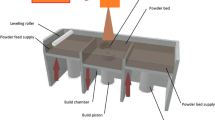Abstract
Selective laser sintering (SLS) is a 3D printing process on a powder bed that presents a real revolution for many industrial sectors; it allows to produce layer by layer precise prototypes, fast, with high dimensional accuracy and with remarkable mechanical characteristics. This technology uses a laser to fuse polymer microparticles, following the geometry of digitally cut CAD models. However, the external surfaces of the parts produced by this process are characterized by a high degree of roughness due mainly to the properties of the powder, the orientation in the build-up tray, and the manufacturing parameters. In this study, selective laser sintering experiments were performed with PA12 powders, in order to analyze the optimal process parameters for the realization of parts with minimal roughness. The process parameters chosen for the study were carefully selected and which are laser power, scanning speed, layer thickness, and scanning space. The samples were printed in different orientations 0°, 45°, and 90°. The Taguchi method was used to study the parameters. Regression equations for each of the orientations were established; these developed a linear relationship between the roughness and the parameters studied.









Similar content being viewed by others
Availability of data and material
Not applicable.
Code availability
Not applicable.
References
Pillot S (2016) Fusion laser sélective de lit de poudres métalliques. Technique de l’ingénieur BM7900
Mauduit A, Pillot S, Frascati F (2015) Application study of AlSi10Mg alloy by selective laser melting: physical and mechanical properties, microstructure, heat treatments and manufacturing of aluminium metallic matrix composite (MMC). Metall Res Technol 112:605. https://doi.org/10.1051/metal/2015039
Deckard CR (1989) Method and apparatus for producing parts by selective sintering. US 4863538A
Tan LJ, Zhu W, Zhou K (2020) Recent progress on polymer materials for additive manufacturing. Adv Funct Mater. https://doi.org/10.1002/adfm.202003062
Kumar S (2003) Selective laser sintering: a qualitative and objective approach. Jom 55:43–47
Rajesh R, Sudheer S, Kulkarni MV (2015) Selective laser sintering process: a review. Int J Curr Engg Sci Res 2:91–100
Kruth JP, Wang X, Laoui T, Froyen L (2003) Lasers and materials in selective laser sintering. J Assembly Automation 23(4):357–371
Pandey PM, Reddy NV, Dhande SG (2003) Slicing procedures in layered manufacturing: a review. Rapid Prototyp J
Goodridge RD, Tuck CJ, Hague RJM (2012) Laser sintering of polyamides and other polymers. Prog Mater Sci 57(2):229–267. https://doi.org/10.1016/j.pmatsci.2011.04.001
Drummer D, Rietzel F, Kühnlein D (2010) Development of a characterization approach for the sintering behavior of new thermoplastics for selective laser sintering. Phys Procedia 5:533–542. https://doi.org/10.1016/j.phpro.2010.08.081
Paolucci F, Govaert L, Peters G (2019) In situ WAXD and SAXS during tensile deformation of moulded and sintered polyamide 12. Polymers 11(6):1001. https://doi.org/10.3390/polym11061001
Van Hooreweder B, Moens D, Boonen R, Kruth J-P, Sas P (2013) On the difference in material structure and fatigue properties of nylon specimens produced by injection molding and selective laser sintering. Polym Test 32(5):972–981. https://doi.org/10.1016/j.polymertesting.2013.04.014
Reddy TJ, Kumar YR, Rao CS (2006) Determination of optimum process parameters using Taguchi’s approach to improve the quality of SLS parts. In: Proceedings of the 17th IASTED international conference on modelling and simulation. 228–233
Zhao M, Drummer D, Wudy K, Drexler M (2015) Sintering study of polyamide 12 particles for selective laser melting. iJES 3(1):34–38
Bacchewar PB, Singhal SK, Pandey PM (2006) Statistical modelling and optimization of surface roughness in the selective laser sintering process. Proc Inst Mech Eng B J Eng Manuf 221:35
Jiang Q, Zhang P, Yu Z, Shi H, Wu D, Yan H, Ye X, Lu Q, Tian Y (2021) A review on additive manufacturing of pure copper. 11:740. https://doi.org/10.3390/coatings11060740
Author information
Authors and Affiliations
Corresponding author
Ethics declarations
Ethics approval
Not applicable.
Consent to participate
Not applicable.
Consent for publication
Not applicable.
Competing interests
The authors declare no competing interests.
Additional information
Publisher's Note
Springer Nature remains neutral with regard to jurisdictional claims in published maps and institutional affiliations.
Rights and permissions
Springer Nature or its licensor holds exclusive rights to this article under a publishing agreement with the author(s) or other rightsholder(s); author self-archiving of the accepted manuscript version of this article is solely governed by the terms of such publishing agreement and applicable law.
About this article
Cite this article
Faraj, Z., Aboussaleh, M., Zaki, S. et al. Optimization of the parameters of the selective laser sintering for the formation of PA12 samples by the Taguchi method. Int J Adv Manuf Technol 122, 1669–1677 (2022). https://doi.org/10.1007/s00170-022-09991-7
Received:
Accepted:
Published:
Issue Date:
DOI: https://doi.org/10.1007/s00170-022-09991-7




